Women, War and Bankruptcy
- 26th August 2025
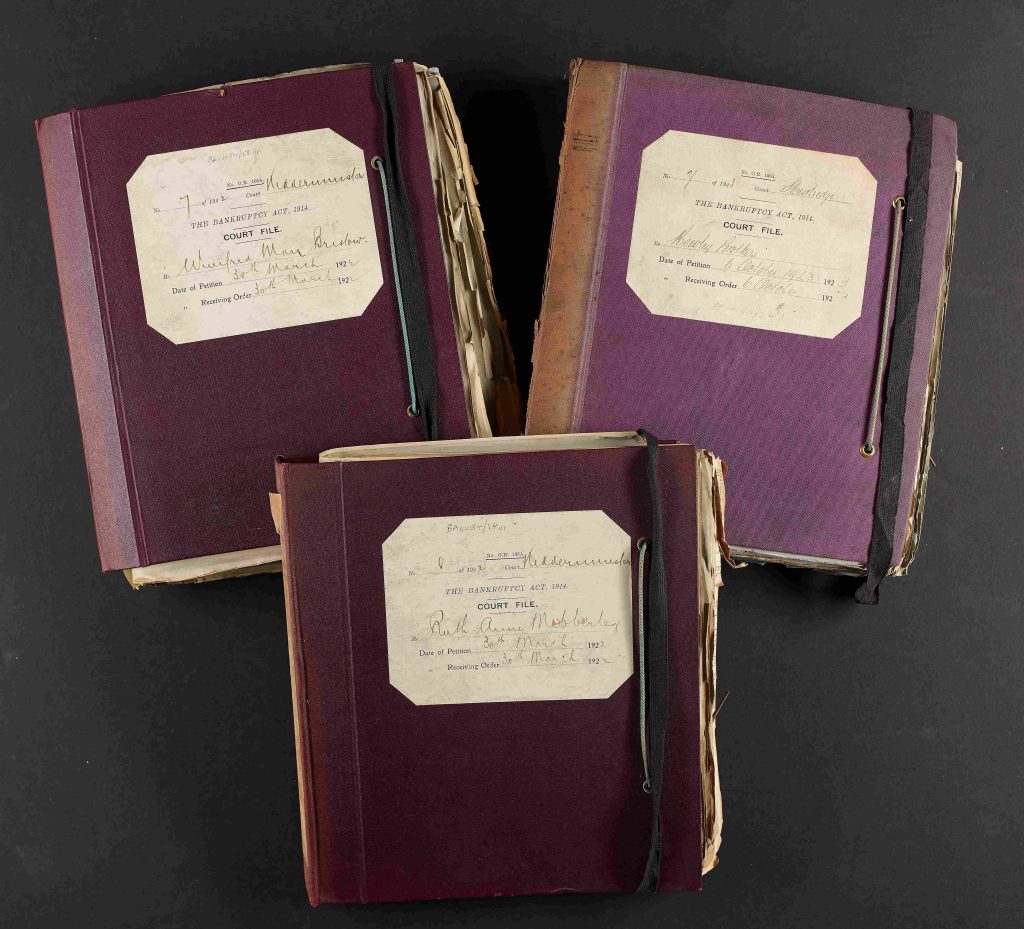
Bankruptcy Case files at Finding Numbers 499.3 BA10034/13/III, 499.3 BA10034/14/III, 499.3 BA10034/24/I © Worcestershire County Court
Amongst the Magistrate Court records held with us on behalf of Worcestershire County Council as part of The Public Records Act are Bankruptcy records from the early 20th century. Whilst they detail the financial situation of individuals and businesses, individual case files which are outside the 100-year closure period can provide insight into the circumstances of the people and their families, and as we shall see, using the 1921 census and other sources demonstrate the social and economic challenges of a nation recovering from the First World War.
Whilst the immense sacrifice of a ‘lost generation’ of men during the First World War (over 750,000 men died under the age of 45) cannot be overstated, the role of Women, many of whom widowed, were heavily involved in the challenges of the Home Front, particularly food production (with 1 million women also employed in munitions work) whilst 100,000 women served in the armed forces and over 40,000 in the Red Cross as Voluntary Aid Detachments.
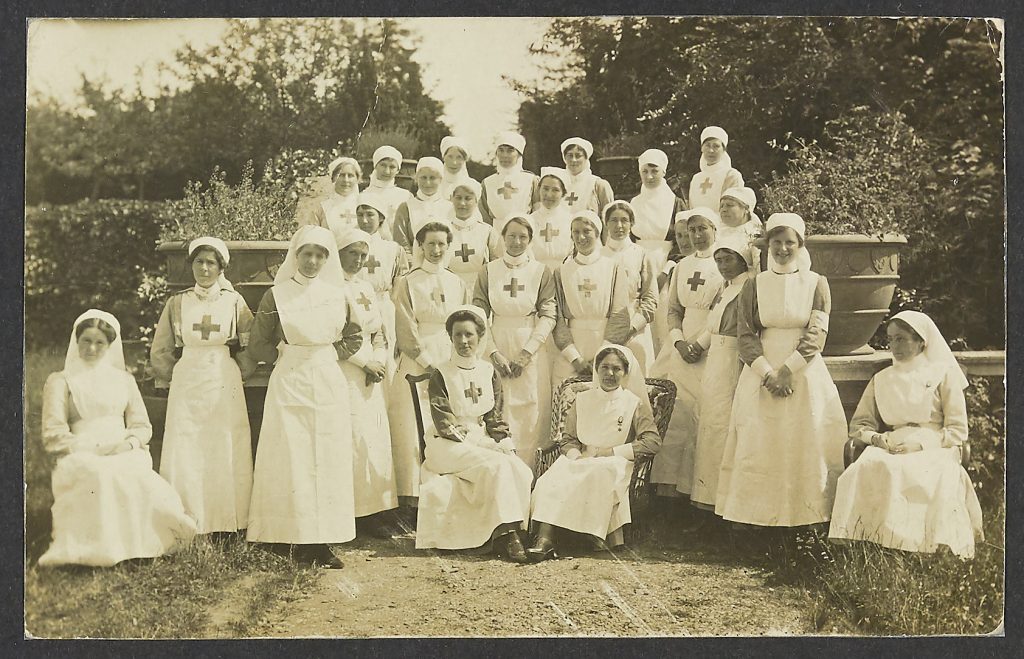
Battenhall Mount Voluntary Aid Detachment (VAD) Hospital grounds with nurses including Edith Weir, Dorothy Weir & Miss Ogilvie c.1917 WPS No: 899:156 78327 © W.W. Harris
Women came to form an important part of the agricultural workforce, as, at the outset of war, there were no restrictions on the recruitment of men. Farmers and agricultural labourers due to poor wages, employment uncertainty and employer pressure, were called up to fight. In Pershore for instance, the home of Market Gardening (where from the late 19th to the mid-20th century, orchards and small plots packed with fruit and vegetables were grown to be sold up and down the country) over 1000 men were called up. Farms and smallholdings like those in Evesham and Pershore relied upon family labour growing a range of foodstuffs and were hit hard when men, and significant numbers of horses (due to the lack of mechanised farming) were sent to the front during First World War.
By 1915, a War Agricultural Committee was set up in each county and with Worcestershire having the highest number of smallholdings in the country, along with jam and canning factories in the Vale of Evesham, it made a significant contribution to national food production. Farmers were encouraged to grow wheat instead of animal husbandry, ploughing up any unproductive land – far from self-sufficient, Britain had relied heavily on imports prior to the First World War.
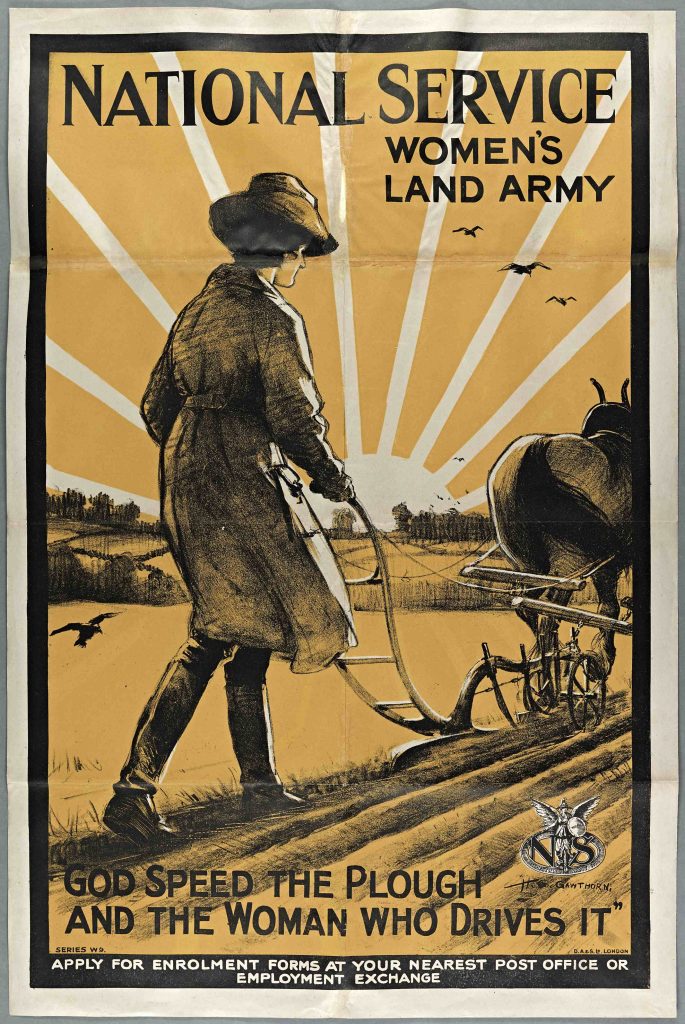
Recruitment Poster for Women’s Land Army titled God Speed the Plough and the Woman Who Drives It c.1917 Finding Number: r261.9 BA5422/4 © Image: IWM (Art.IWM PST 5996)
Whilst the Women’s Land Army, established in 1917 led to women playing a key role in the cultivation of agricultural land, with a need to plough land for cereals or potatoes, many middle-class and wealthy women were uncertain what their role should be during the conflict. Where possible, women also undertook charitable work and joined a wide range of organisations, as shown here with Women volunteering at their local fire service.
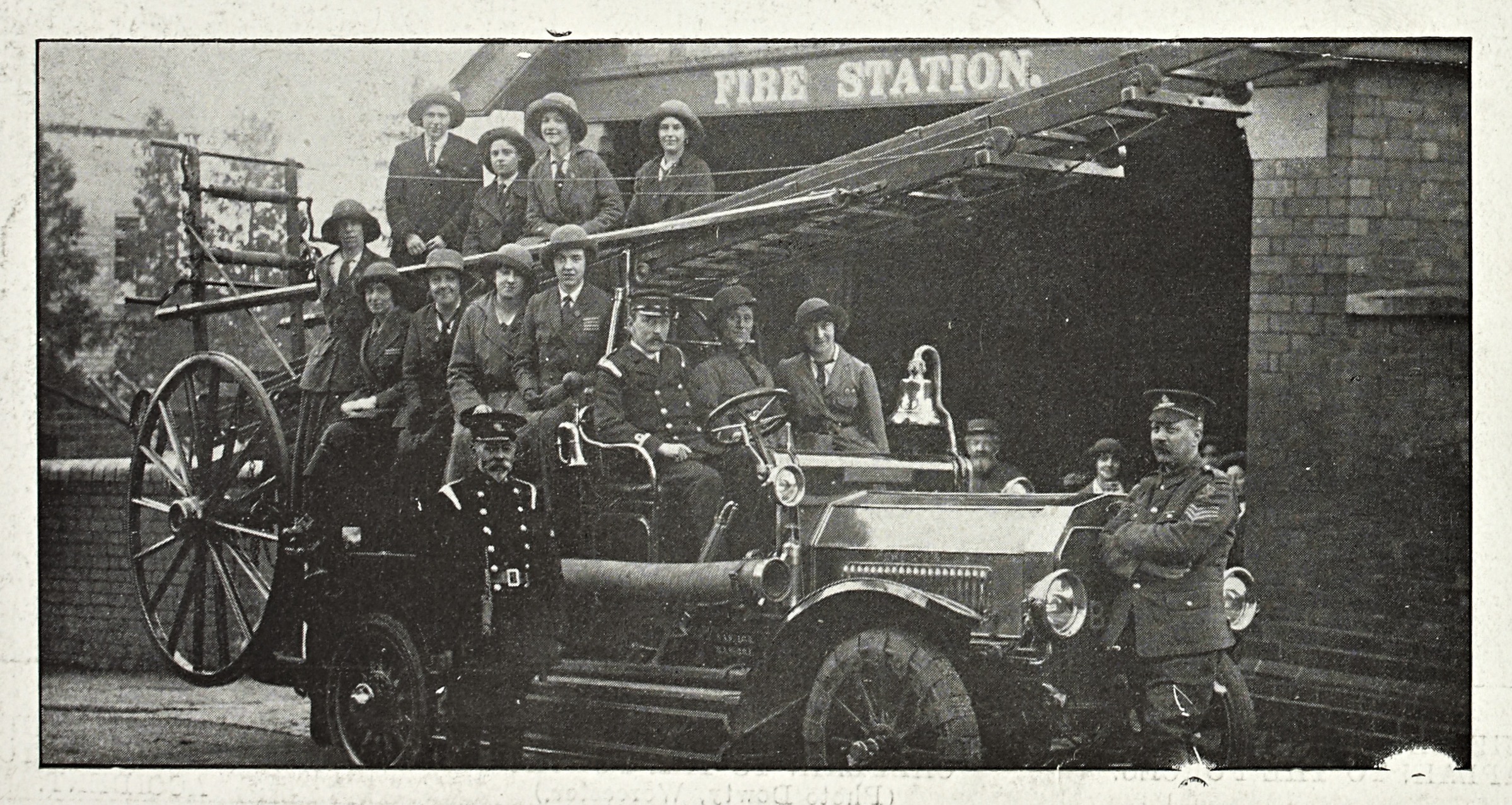
Malvern Women’s Volunteer Reserve, Berrow’s Worcester Journal Pictorial Supplement 25th March 1916 Local Studies Collection © Newsquest
Newspaper articles were quick to make suggestions about women’s role at home, in securing food at a fair price, without impacting those less fortunate, who were unable to take the strain of higher food prices.
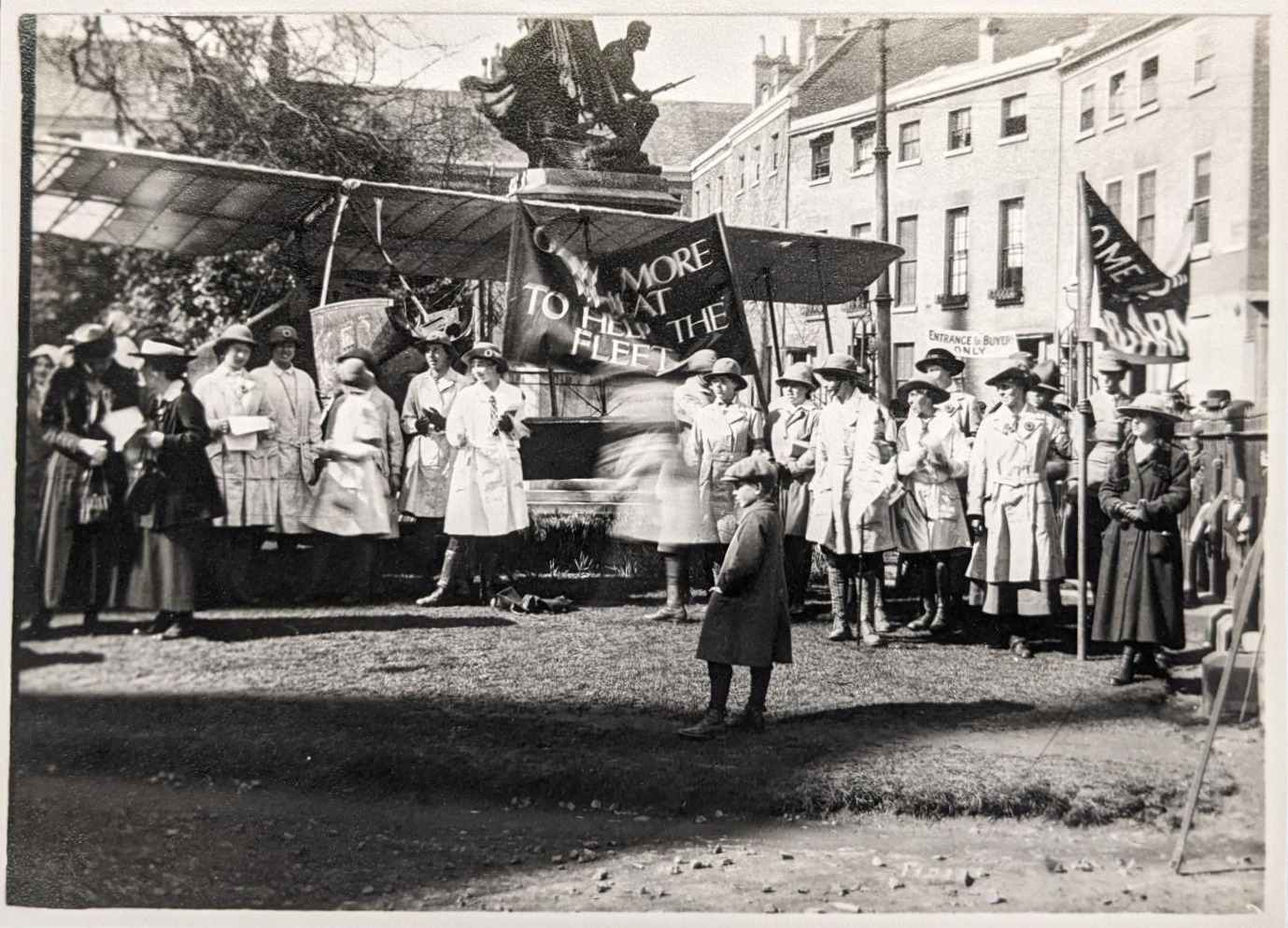
Land Army girls supporting the ‘grow more food campaign’ Worcester City: Cathedral Grounds c.1918 WPS No: 899:156 76031 © Unknown
Panic buying led to escalating food prices during the first week of the War and concerns over food economy intensified. By 1916, following naval blockades, food shortages were becoming acute, with reports of discussions in parliament over the doubling of the price of potatoes and in Worcester, with large queues for these and staples such as margarine reported. The Ministry of Food wanted to reach the housewife or women at home, and it did so, in part through its propaganda campaigns for food economy. The government recognised that women were on the front line in the fight to secure adequate food supplies at home and were key to avoiding food wastage for them and their families.
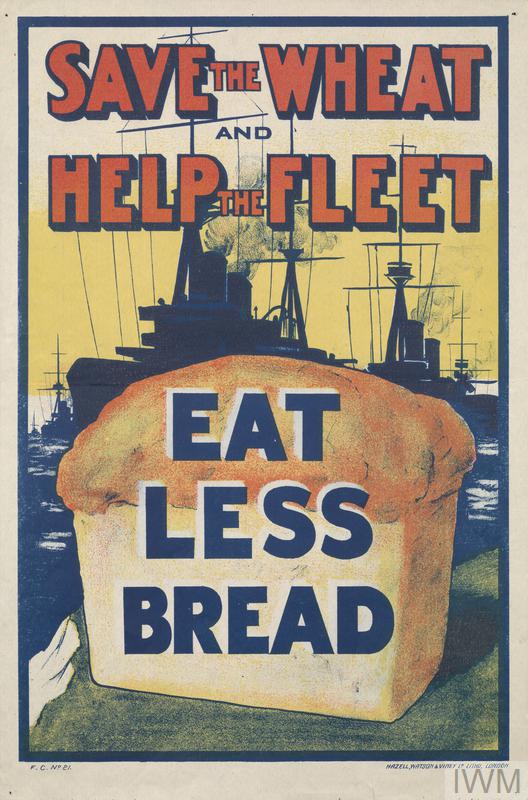
Save The Wheat Help The Fleet Eat Less Bread Propaganda Poster encouraging everyone, but especially women on the Home Front to take a lead on food economy © Image: IWM (Art.IWM PST 4470) Available at: <https://www.iwm.org.uk/collections/item/object/41180>
The Ministry later set-up Food Control Committees to safeguard the interests of women at home and consumers amidst the worsening food crisis. Women at the time could voice their concerns through Food Vigilance Committees, set up in 1917 to democratise food control. This was in the wake of spontaneous protests by housewives, such as in Edmonton, where a milk supplier was boycotted to demand a milk depot being established and food riots in Bermondsey and rural Cumberland due to potato shortages.
It is through Bankruptcy records for two women, Ruth Anne Mobberley and Winifred Mary Bristow who ran a farm and grocery business during this period that we can illustrate the challenges of growing food for the war effort and the negative impacts on their family and respective businesses. Firstly, though, what do Bankruptcy case files include?
Bankruptcy case files provide a summary of the administrative process of Bankruptcy for individuals or businesses. This includes a summary of the formal court hearing and a meeting where the Official Receiver’s report for the estate is given with the Creditors. It includes a detailed list of money owed to Creditors and the Debtor’s Petition describes their case and circumstances as described by the Official Receiver. There is a written statement of the Debtor by an Examiner who asks a series of questions, which describes in detail their estate and a statement of their affairs, which is often deeply personal and describes family circumstances. It includes a signed notice by the County Court Registrar, confirming the Bankruptcy.
Ruth Anne Mobberley
Using Ruth’s Bankruptcy case file, we can learn a lot about her personal circumstances and difficulties that she faced with her family in part as a result of the weather and the First World War. We know that she was 56 years old, residing at Ismere House Farm, Kidderminster as described by the Official Receiver’s summary which describes the meeting with her Creditors and also the Public Examination of the Debtor.
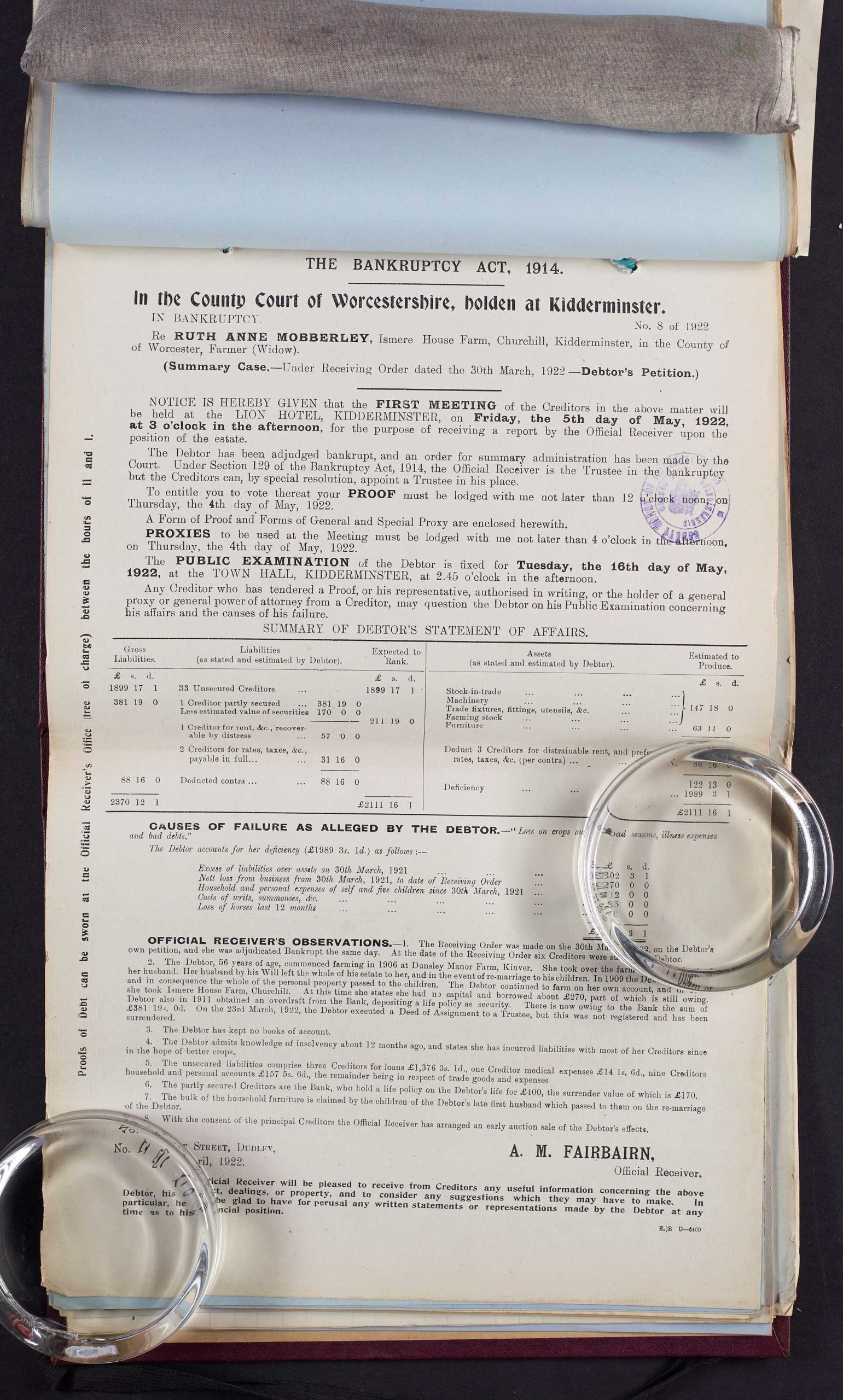
Official Receiver’s Bankruptcy summary for Ruth Anne Mobberley at Finding No: 499.3 BA10034/14iii/47 © Worcestershire County Court
Her reasons for Bankruptcy are stated as ‘Loss on Crops owing to Bad Seasons, Illness Expenses and Bad Debts’ and the Receiver’s Observations state that money was lost through net losses of the business, family expenses of herself and her five children, including the loss of horses. Horses were certainly required for the War effort, but this seems very late given it was 1921 and the war was over, so whether they died, exported or were needed by the military is unclear. However, claims of ‘Bad Seasons’ are backed up by evidence, with a Bad Wheat harvest in 1916 which affected Britain and Europe due to severe Atlantic storms. Britain was left with only 6 weeks of wheat supply and due to a reliance on imports and increasing numbers of cargo ships being sunk, bread became more expensive and difficult to buy. Other crops such as potatoes also failed due to a long harsh winter leading to famine in 1917.
Referring to her Bankruptcy Case file testimony, we can see that Ruth states that she received ‘almost nothing from her corn crops – they were almost a failure’. In 1921, we can trace her on the Census and in her testimony, she states that she started her business in March, 1913. Owing to the death of her first husband Mr. Glover who she farmed with at Dunsley Manor Farm, Kinver, everything was left to her, but this was subject to her not re-marrying.
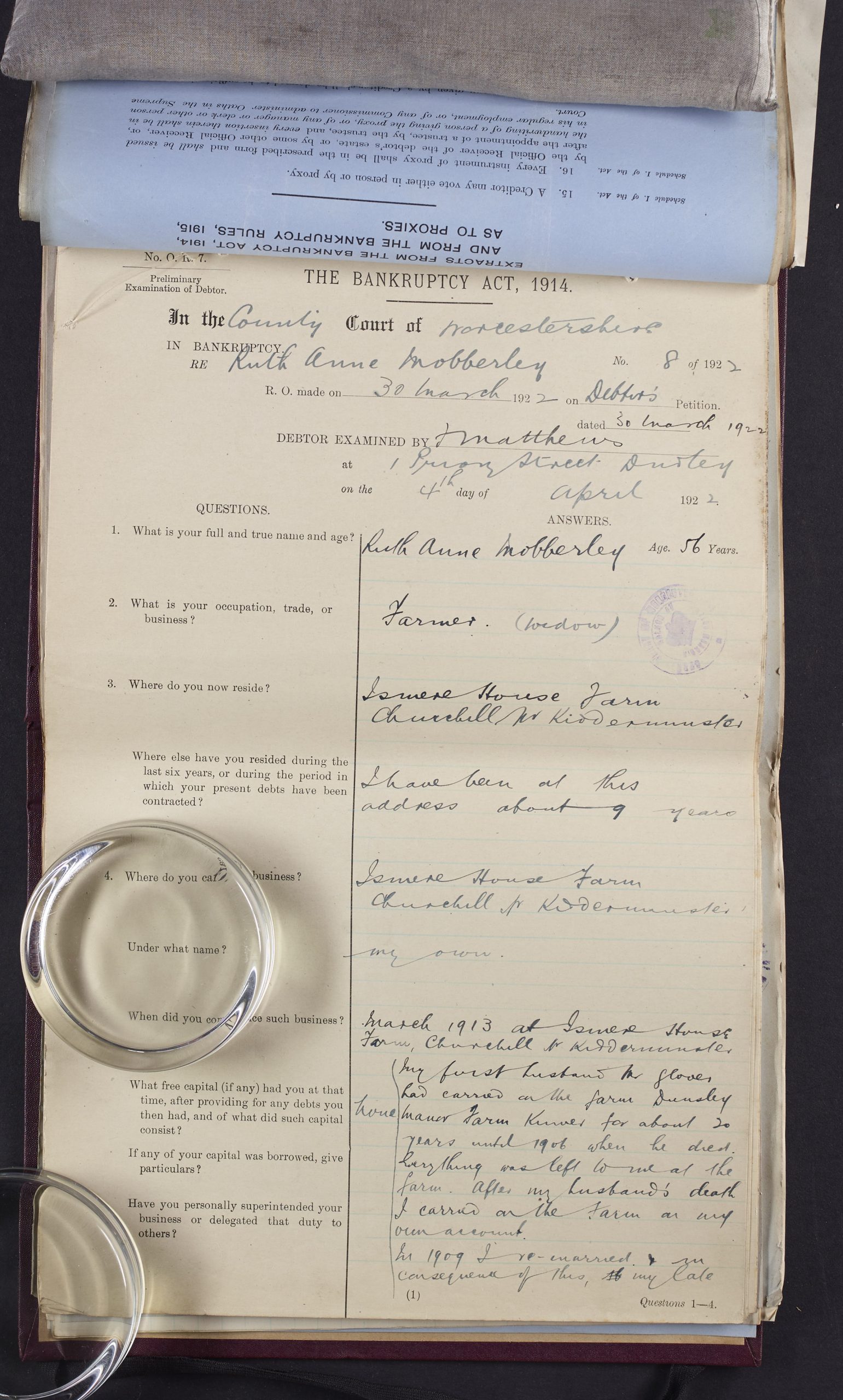
Extract of statement by Ruth Anne Mobberley as part of her Debtor’s Petition dated 30th May, 1922 at Finding No: 499.3 BA10034/14iii/52 © Worcestershire County Court
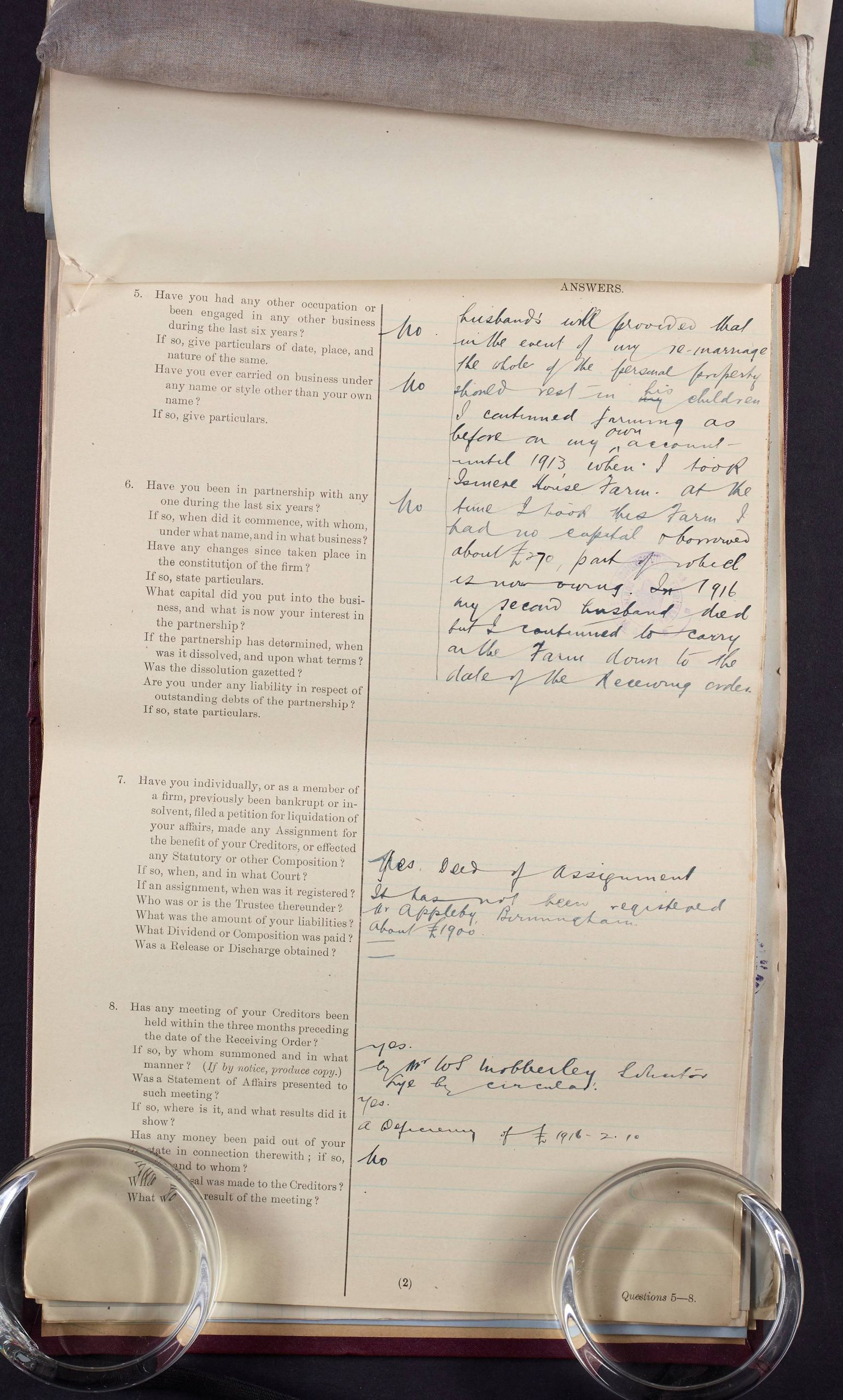
Extract of statement by Ruth Anne Mobberley as part of her Debtor’s Petition dated 30th May, 1922 at Finding No: 499.3 BA10034/14iii/53 © Worcestershire County Court
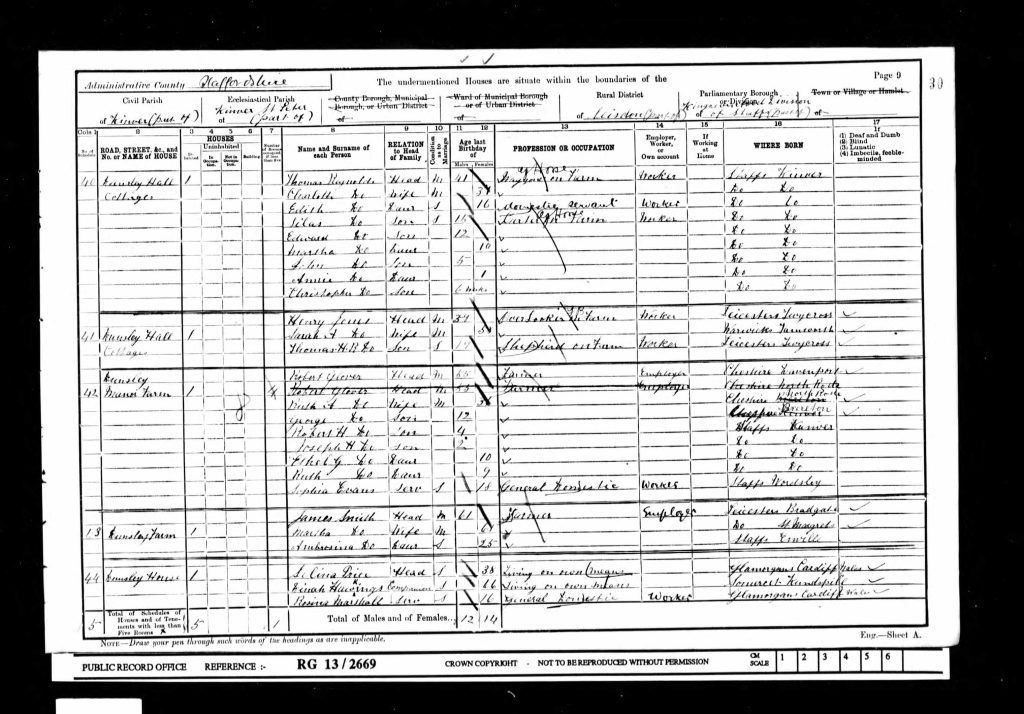
Ruth Glover shown with her family on the 1901 Census at Dunsley Manor Farm, Kinver. © Crown Copyright
On the 1901 Census, aged 31, Ruth is shown with her husband Robert Glover and six children. As stated in her testimony, Ruth re-marries and as a result, any furniture and property passes to Mr. Glover’s children in the Will. Ruth states she re-marries in 1909 and continues to farm until 1913, when she came to Ismere House Farm.
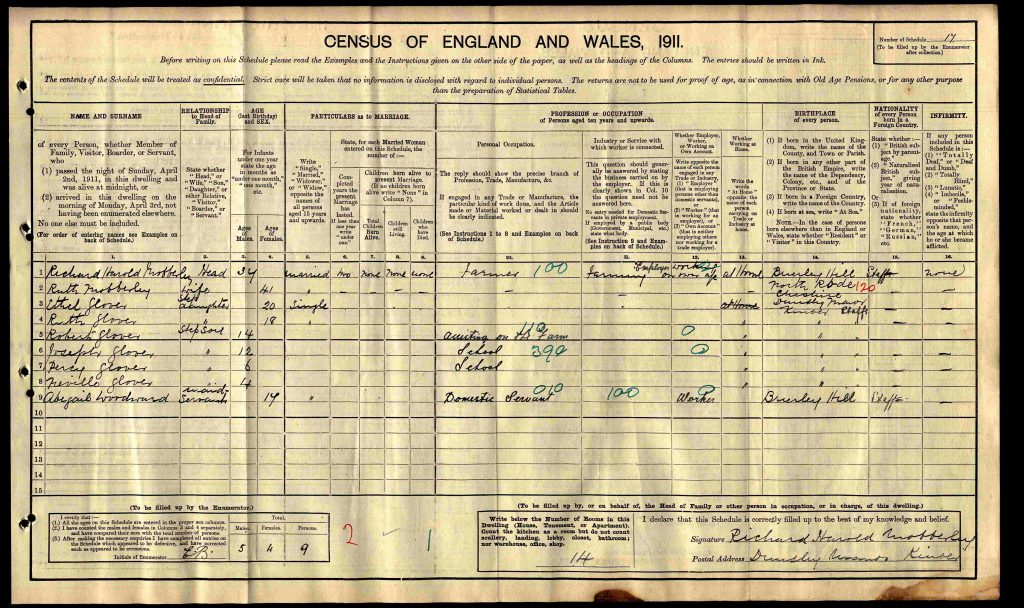
Ruth Anne Mobberley shown with her second husband Richard Harold Mobberley and his stepchildren on the 1911 Census at Ismere House Farm. © Crown Copyright
Ruth is shown on the 1911 Census as having married Richard Harold Mobberley with Ruth’s children from her first marriage also listed as living at Ismere House Farm. Having no capital at the time, Ruth states she took a loan of £270 to shore up the business. Tragedy then strikes within a few years as Ruth’s second husband dies in 1916 (though not at the Western Front) so Ruth had to utilise all her knowledge to run the business independently with her four sons at a very challenging time. It is unsurprising, given the circumstances of poor profits, bad harvests, previous bad debts and the expense of five children, that the farm slides into Bankruptcy at the end of the First World War.

Ruth Anne Mobberley, Widower, shown as Head of household and Farmer of Ismere House Farm with her four sons and Robert Horace Glover, Farm Manager on the 1921 Census. © Crown Copyright
Winifred Mary Bristow
Winifred Mary Bristow’s case file dated 30th March 1922 also makes for a sobering read of economic failure, this time, not through a loss of crops, but in part due to the lack of meat available during the First World War. We first see Winifred, aged 30 listed on the 1911 Census, married to her husband William Bristow, who is a Shop Assistant in Stourbridge with her son and father. By the 1921 Census, she is listed as working at 22, Market Street, Tenbury, but what led to her becoming a business owner who was bankrupt by the end of 1922?
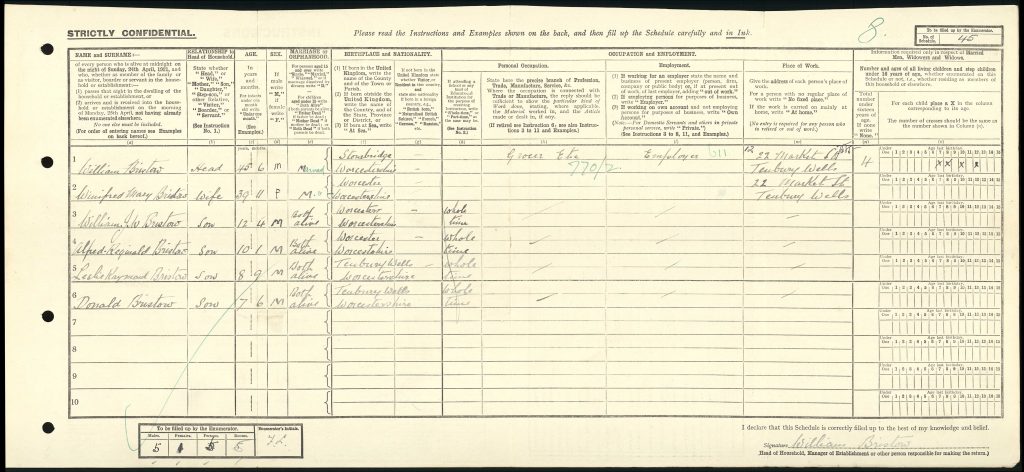
Winifred Mary Bristow shown on the 1921 Census as living at 22, Market Street, Tenbury, with her family © Crown Copyright

Official Receiver’s Bankruptcy summary for Winifred Mary Bristow at Finding No: b499 BA10034/13iii/94 © Worcestershire County Court
The Official Receiver’s Bankruptcy summary states that Winifred in 1922 was filing for Bankruptcy for her Fruiterer, Butcher and Grocer’s business with a loss totalling £1161.8s.5d. (nearly £50,000 in today’s money!) Winifred states the factors which contributed to her Bankruptcy were “Losses on Meat Sales during the war, owing to absence of husband, losses on meat going bad during hot weather and takings falling off”. Indeed, this appears to be a very accurate picture as to the root cause, alongside bad debts and the expenses of her four children, when we consider the impact of the First World War.
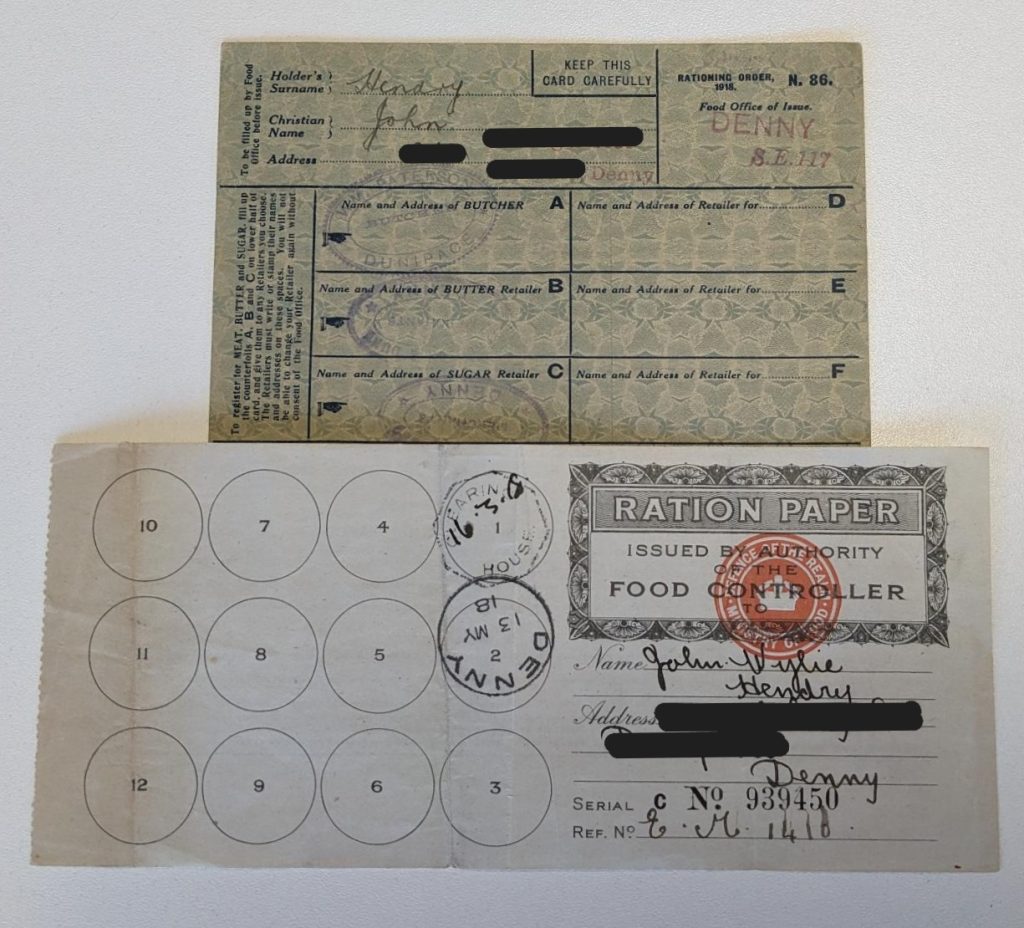
Food Ration papers for John Wylie Hendry of Dunipace, East Stirlingshire c.1918 Finding No: 705.1206 BA10947/3-4 © Unknown
A survey of fat stock at fifty-nine British markets demonstrates the supply of fresh meat and the drastic short-term acceleration of this, comparing Cattle, Sheep and Pigs at 16, 234, 71,896 and 14,283 in January 1917 to only 5,725, 48,427 and 4,162 in January 1918. Meat was in short supply and historian Adrian Gregory states food had become “a public obsession”. Obtaining reduced supplies was a time-consuming, tiring and demoralising business, a burden which fell principally on women. Queuing became a daily occurrence with working women using their lunch hours or losing pay when they took time to shop.
In early 1918 rationing was introduced following severe food shortages with four-fifths of wheat, one-third of meat and all sugar being imported and Ministry of Food Propaganda leaflets claimed Germany was trying to starve Britain out with attacks of supply lines by their U-Boats. Meat, Butter, Sugar and Milk were rationed, with furniture and clothing also obtained in exchange for money and coupons. A person had to identify a specific grocer or shopkeeper and if their allowance had already been claimed, it was illegal for someone like Winifred to sell products to a customer and if breaches occurred, people could face fines and/or imprisonment.
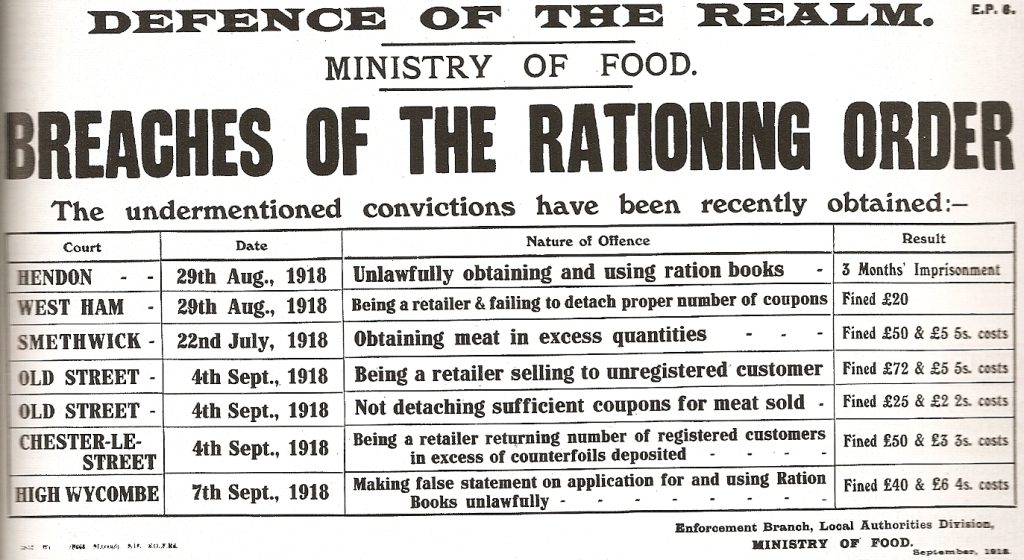
Breaches of the Rationing Order leaflet describing various penalties given out to people breaching the wartime rationing legislation produced by the Government’s Ministry of Food. September, 1918 © Public Domain Available at: <https://en.m.wikipedia.org/wiki/File:%27Breaches_of_the_Rationing_Order%27_poster.jpg>
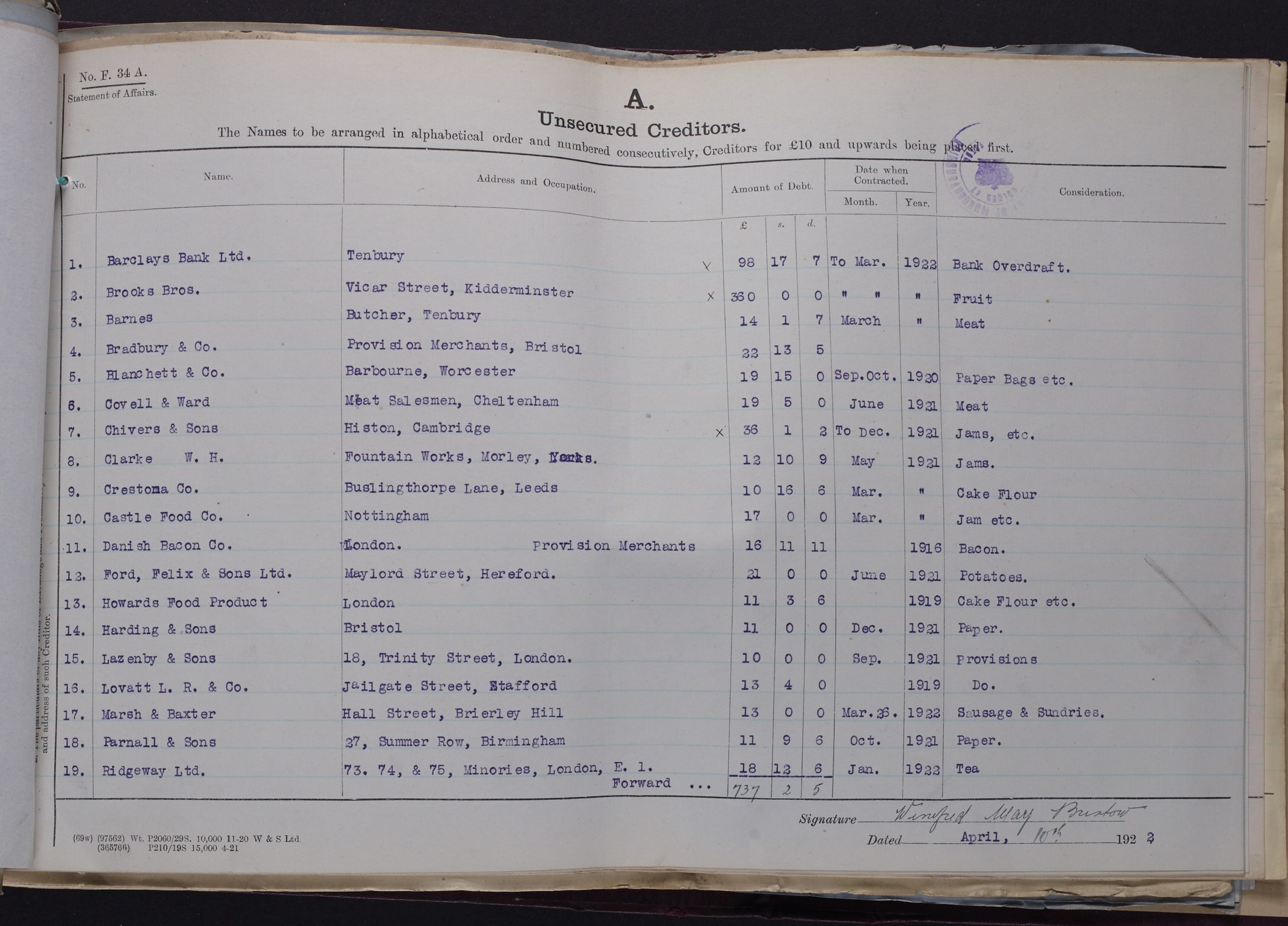
One page of the Bankruptcy Case file which lists Winifred Mary Bristow’s Creditors and the goods and services received and costs of each at Finding No: b499 BA10034/13iii/100 © Worcestershire County Court
Winifred’s case file lists her many Creditors to which she owed money too and demonstrates the mileage to which some goods were arriving to her shop in Market Street, Tenbury from and include canned goods suppliers of peaches, kippers, pineapple and apricots, cake makers, jams and meat salesman and butchers providing some bacon, sausages and provisioners of dairy goods. Rather movingly, one of the creditors is for herself and her sons’ clothing including tennis shirts, flan trousers and coat – perhaps their school clothes.
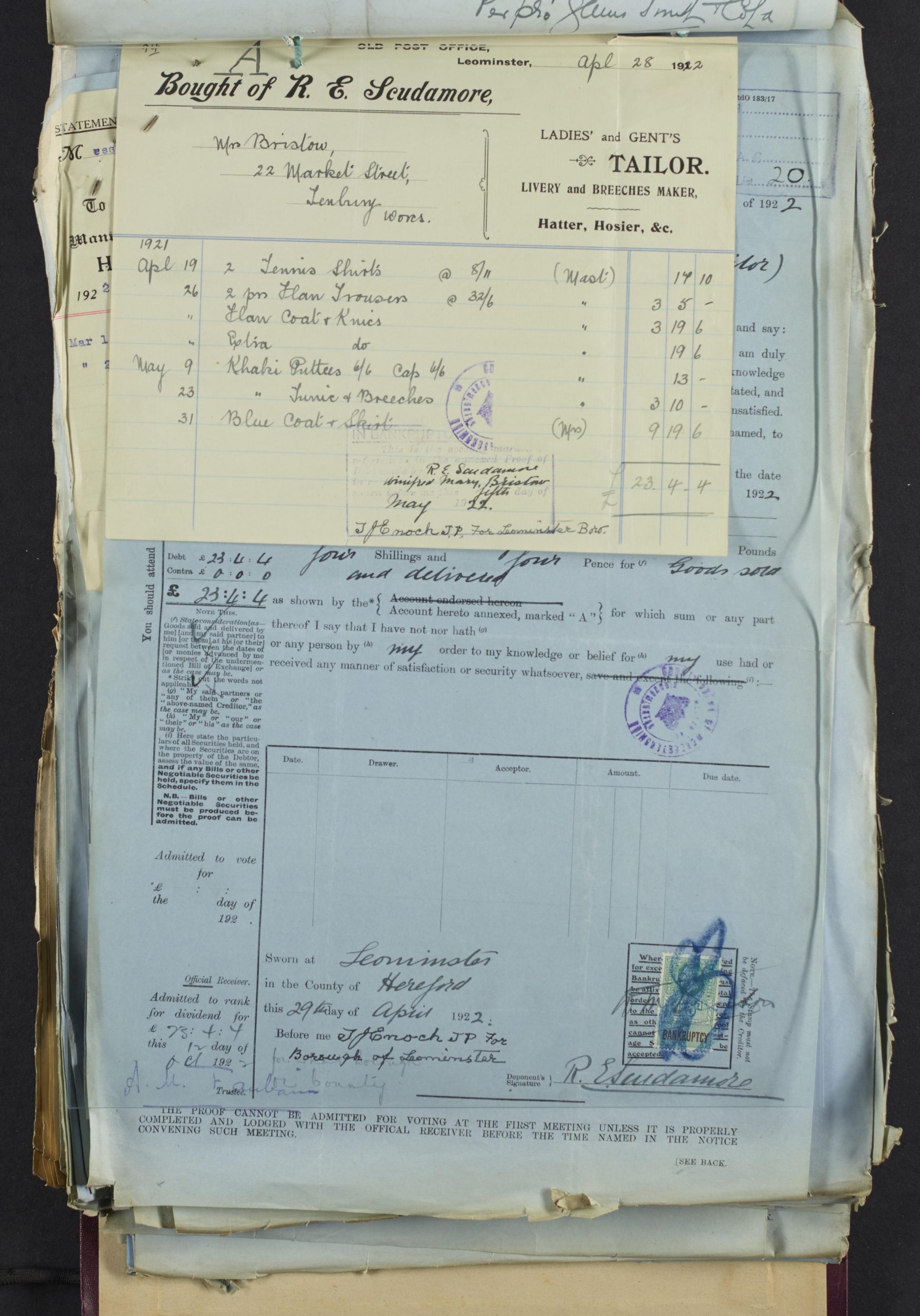
One page of the Bankruptcy Case file which summarises the amount owed by Winnifred Mary Bristow to Creditor R.E. Scudamore, Leominster which lists the clothing items purchased for herself and her sons’ at Finding No: b499 BA10034/13iii/29 © Worcestershire County Court
Winifred describes in her testimony how as her husband was away fighting between 1915 and 1919 in India, in her own words “The business went down, I could not get any meat – the Colonial Meat was stopped – I could not get English I had no one to kill”. She goes on to say that she gave up on the Meat trade during the war having literally nothing to sell.

Extract of statement by Winifred Mary Bristow as part of Debtors Petition for Bankruptcy at Finding No: b499 BA10034/13iii/90 © Worcestershire County Court

Extract of statement by Winifred Mary Bristow as part of Debtors Petition for Bankruptcy at Finding No: b499 BA10034/13iii/91 © Worcestershire County Court
Like Ruth Mobberley, her husband had borrowed some £100 in capital to keep the business going following his return from the army, when the business was in “low water” and things started to pick up with the Fruit trade. Winifred then states that “I was picking up last summer and we were doing better in the meat trade but owing to extreme heat it was £100 loss from meat going bad.” We know from reports of the weather in 1921 that high pressure systems from the Azores remained stuck for almost the entire year, leading to clear skies and dire shortages of rain – the principal cause of Winifred Bristow’s meat going off. Indeed, the drought is also believed to be the source of inspiration for T.S. Elliot’s writing of his famous poem “The Waste Land” – a reflection on the First World War.
An extract from T.S. Elliot’s The Waste Land:
Here is no water but only rock
Rock and no water and the sandy road
The road winding above among the mountains
Which are mountains of rock without water
If there were water we should stop and drink
Amongst the rock one cannot stop or think
Sweat is dry and feet are in the sand
If there were only water amongst the rock
Dead mountain mouth of carious teeth that cannot spit
Here one can neither stand nor lie nor sit
There is not even silence in the mountains
But dry sterile thunder without rain
There is not even solitude in the mountains
But red sullen faces sneer and snarl
From doors of mudcracked houses
If there were water
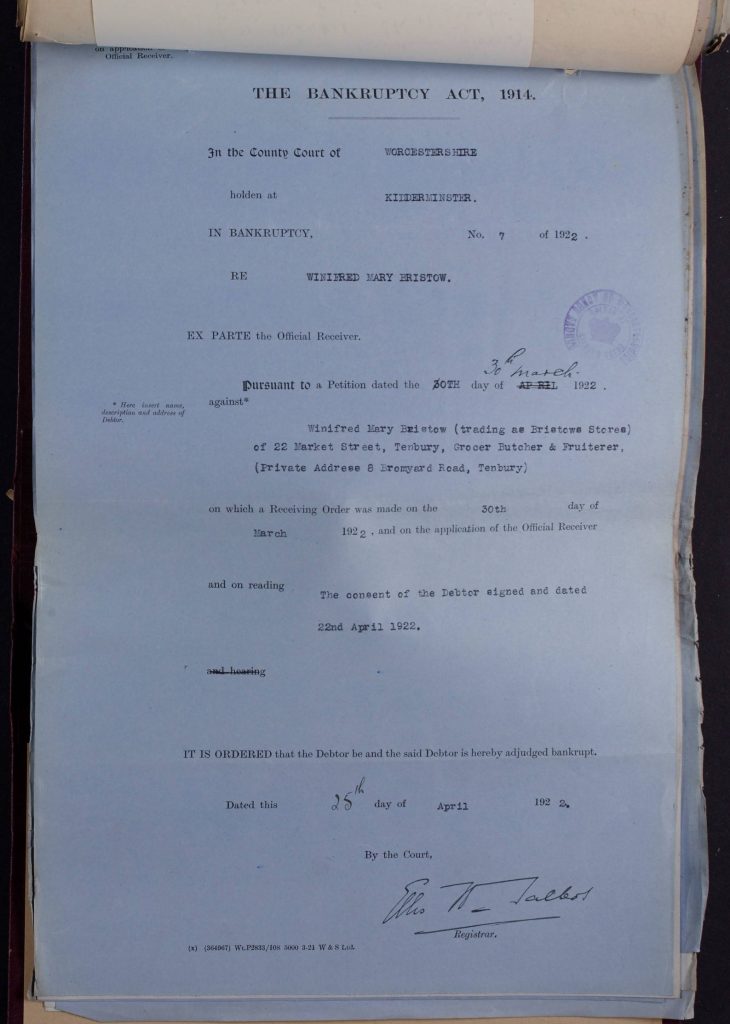
Confirmation of Bankruptcy notice for Winifred Mary Bristow as part of Debtors Petition for Bankruptcy at Finding No: b499 BA10034/13iii/116 © Worcestershire County Court
Bankruptcy records like those for Ruth and Winifred demonstrate the challenges of growing food, running businesses and taking care of ones’ families, during periods of social and economic uncertainty. Today, we also live at a time of high food inflation and a cost-of-living crisis where food banks have become the norm in many towns and cities. Due to the Covid-19 pandemic food prices rose, and foods such as pasta and flour became difficult to procure. As a result of climate change, we are also experiencing more frequent heat waves (as shown this year), damaging storms, floods and wetter winters which prove challenging for future food production, supply chains and producing other goods. These records illustrate both the impact of war and extreme weather events and are a powerful reminder for us all about the value we should place on the food that we grow as well as taking care not to waste food and resources.
Sources used:
Andrews, Maggie, Adrian Gregson & John Peters Worcestershire’s War – Level 2 Local Studies – L942.44083
Gregory, Adrian – The Last Great War – Level 2 Local Studies – Level 2 Local Studies – L940.341
Andrews, Maggie & Lomas, Janis – The Home Front in Britain – L940.341 AND
The National Archives – Home Front Stories – Fighting Through Food
Imperial War Museum – 12 Things You Didn’t Know About Women in the First World War
Vad Red Cross – Women’s involvement in the Red Cross during the First World War
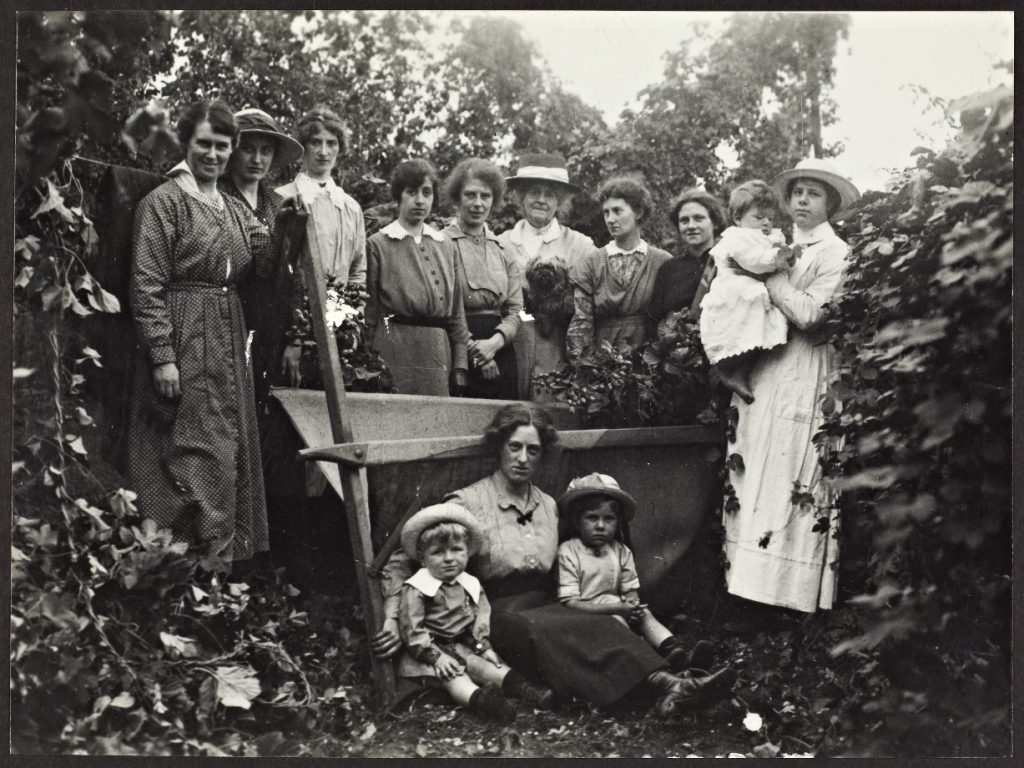

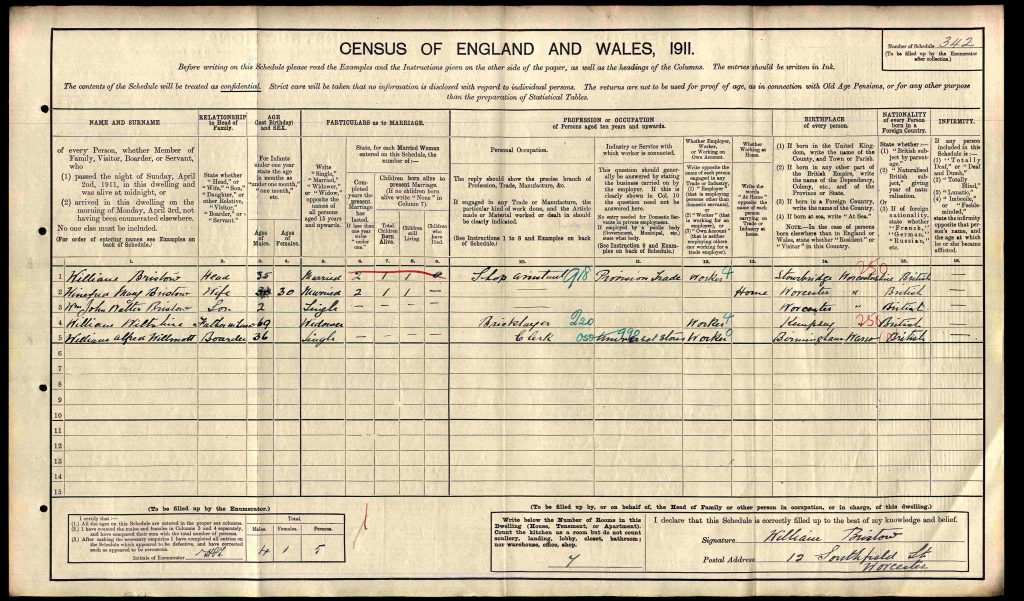
Post a Comment